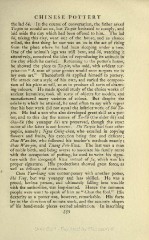Page 441 - Oriental Series Japan and China, Brinkly
P. 441
CHINESE POTTERY
the lad Sit. In the course of conversation, the father asked
Ta-pin to mould an ox, but Ta-pin hesitated to comply, and
laid aside the clay which had been offered to him. The lad
Sit, taking this clay, went out of the house, and as chance
willed, the first thing he saw was an ox in the act of rising
from the place where he had been sleeping under a tree.
One of the animal's legs was still bent, and Sit, watching it
attentively, conceived the idea of reproducing its attitude in
the clay which he carried. Returning to the potter's house,
he showed the piece to Ta-pin, who said, with evident sur-
"Aprise :
man of your genius would soon surpass me in
my own art." Thenceforth Sit applied himself to pottery.
He struck out a style of his own, and varied the composi-
tion of his pates at will, so as to produce all sorts of charm-
Heing colours.
made special study of the choice works of
ancient keramists, took all sorts of objects for models, and
manufactured many varieties of colour. But despite the
celebrity which he attained, he used often to say with regret
that his best work did not equal the inferior work of Shi Ta-
Hepin.
had a son who also developed great skill as a pot-
ter, and to this day the names of Ta-Su (the elder Su) and
Siao-Sii (the younger Sii) are preserved, though the exact
name of the latter is not known. Shi Ta-pin had four other
pupils, namely ; Ngeu Ching-chun, who excelled in copying
flowers and fruits, his execution being fine and delicate
;
Shao Wan-kin, who followed his teacher's methods exactly ;
Shao Wan-yin, and Tsiang Poh-Kwa. The last was a man
of noble birth, and being averse to associate his family name
with the occupation of potting, he used to write his signa-
ture with the ideograph Kwa instead of fu, which was his
proper signature. His productions showed great force, as
well as delicacy of execution.
Chan Tun-hiang was contemporary with another potter,
HeShi Ting, but was younger and less skilled.
was a
proud, lawless person, and ultimately falling into trouble
with the authorities, was imprisoned. Hence the common
people were wont to speak of him as " Chan the fool." His
dexterity as a potter was, however, remarkable. His forte
lay in the direction of minute work, and the accurate shapes
of his hand-made pieces excited admiration. In inscribing
359

